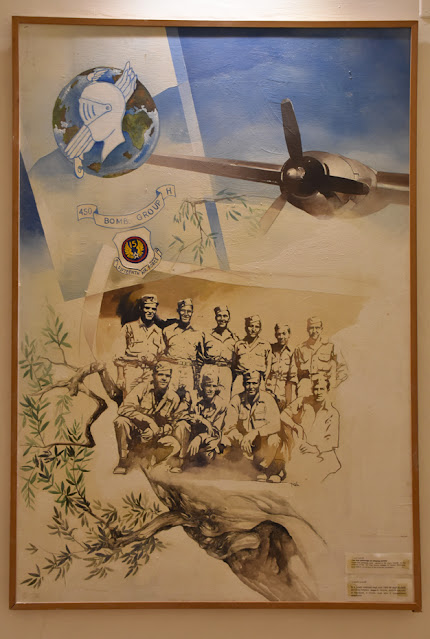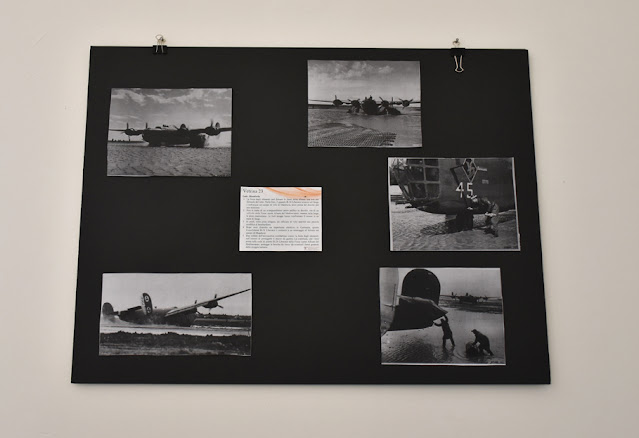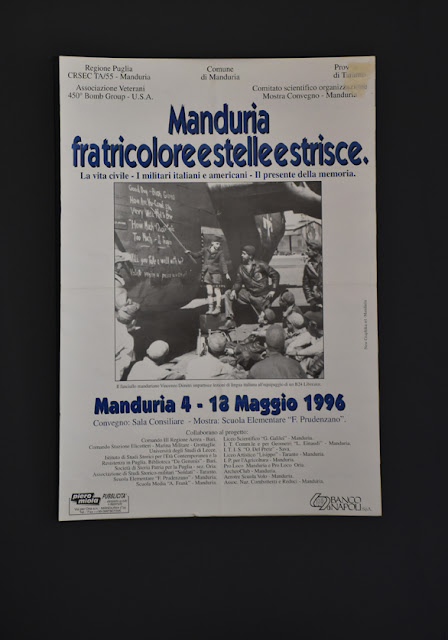Let’s dive
in the modern history of Manduria and discover how stories of collaboration
between peoples of different language and culture can arise. Let’s visit the
Civic Museum of Manduria.
I’ve
already talked to you about Manduria on this blog: I guided you along the
streets of its old town centre, we dived in its history to meet the Messapians,
we tasted its wine loved in the world, I showed you the beauty of its sea and its natural wonders.
Today I’m talking to you again about the town of Primitivo wine to guide you in another place that keeps the memory of the people of Manduria. Let’s discover together the Civic Museum of Manduria dedicated to the Second World War.
Don’t let
the introduction scare you. It’s true , we’re talking about a horrible period
and each year we remember its atrocity, but the Civic Museum of Manduria wants
to tell something that usually is left out in favour of historical facts: here
we talk about the life of the people of Manduria and, in particular, about
their relationship with the American aviators who had been based in this area
for 14 months, between 1943 and 1945. The Museum tells the human side of that
period.
The creation of the Civic Museum
Its name is
Museum of the Second World War, but it also hosts witnesses dating back the
Great War, especially, as we’ll see further, referring to the warm hospitality
that characterizes the people of Manduria.
The visit of the Civic Museum of Manduria
Let’s enter
Palazzo delle Servite, a noble palace dating the 18th century in the old town
centre. We coast the refined cloister, with an elegant well in the middle, and
go upstairs on the first floor. After a brief staircase, here we are in the
Civic Museum.
Four large
paintings realized by the creativity of the students of art high school,
inspired by some photographs of that time, welcome and guide us toward the
museum itinerary of memory. In a large room, several showcases, which collect many items, are neatly organized. From the
door, we can already see military uniforms and photographs from long ago.
Men
captured in photo while trying not to get bogged down tell how the Americans of the 450th
Bomb Group arrived to Lake Manduria. It
makes smile that the muddy area formed in December because of stagnation was
defined “lake”.
Anyway,
that was enough for the Americans to roll up their sleeves in order not to make
the planes get bogged in muddy soil. Memories start to materialize in the items
around us.
Pierced
steel planking: we see them in the hands of the soldiers to prevent trucks and
planes sink in mud; we turn our heads and see them on the wall, directly from
the 40s of last century, as they’ve travelled in time.
There also
are specific military elements, as the precision pointer used by bombardiers.
Some items are there to remember the period that, with this exhibition, we’re going
through, in case we got distracted and forgot which years we’re talking about,
thanks to the humanistic story set in the museum.
Manduria, like a large part of Puglia, didn’t perceive directly the horror of war; they
rather suffered the hunger that came from it. With the arrival of the Americans,
some activities had to adapt to the needs of the war, like the propagandistic
one, the informative one, but also the entertaining one. We’re always talking
about men, boys, who found themselves fighting a war.
As we’re
talking about men, here that some colour notes emerge and tell about these
people, about their life in Manduria and about the way the people of Manduria
adapted themselves to the Americans and to the situation.
The
information that come to us were documented by the press of that period, in
particular by the weekly magazine The Bomb Blast: it was written in American
English and reported news of any kind. One of them was the announcement of the
opening of a laundry, where they stressed the guarantee of hygiene. Now we take
it for granted, but in Puglia of the 40s hygienic conditions weren’t those
we’re used nowadays.
They also
found a warning for American aviators: they absolutely had to beware of the
Purple Death. What was it? Well, we’re in Manduria, the town of Primitivo wine:
the Purple Death actually was the wine, or better to say the effects caused by
it.
Primitivo
is a quite strong wine, whose alcohol content is about 18%. If you’re not used
to it, it goes down wonderfully, but equally softly leads you in the arms of
Bacchus. So, aviators, who had to drive trucks and planes, had to be careful
with wine, because the risk of serious accident was real.
Let’s
continue and see a poster with an interesting photograph: a boy, standing on a
stool, who teaches Italian to the Americans. It’s a beautiful witness of the
collaboration between peoples of different language and culture, despite the
circumstances that brought them together.
We get
closer to read the sentences the boy is teaching and soldiers are so interested in learning:
Buongiorno, come state? (Good morning, how are you?), Vorreste passeggiare
con me? (Would you like to go for a walk with me?) and we can’t hold a
mischievous smile. Surely, those were useful sentences and, apparently, also
efficient, as we know that there had been several marriages between the Americans
and the women of Manduria!
When the Americans
left Manduria, they also left many objects. Besides pierced steel planking,
they found several bomb holders, tin boxes and even trucks. The people of
Manduria collected that stuff and reused it: pierced steel planking became
excellent gates; bomb holder were used as stools or readapt in creative ways to
face everyday life needs. So, the people of Manduria gave free rein to their
innate creativity to turn those “wastes” to their advantage.
The Heroes of Manduria
A big showcase
is dedicated to two heroes of Manduria. According to their lives, they honoured
the town and brought a witness of that period: they are Cosimo Moccia and Elisa
Springer.
Cosimo
Moccia was a carabiniere decorated with Gold Metal of Military Valor for having
chosen death with his companions, war prisoners, rather than betray his country
and reveal the names and the hiding places of partisans who he had joined.
The letters
shown on the totem define his profile as a man, with his hopes and his desire
of coming back home to his family. Nothing in those texts let foresee what then
would have really happened.
Next to it, the
showcase dedicated to Elisa Springer tells the story of this Jewish woman, born in
Vienna, but grown up in Manduria, survived to holocaust. After many years of
silence, she decided to dedicate her life to the witness of what she had lived,
in order to make know the horrors she had to suffer, with the hope that
knowledge can prevent them happening again.
A wall
covered with photographs shows the faces of posed young men. They’re the sons
of Manduria, who lost their life during the Second World War; some of them are
the victims of Shoha and sinkholes. It’s a way to give them dignity and to
thank them for their sacrifice. They’re here with their stories and bring their
witness.
The Photographic exhibition about the First World War
We leave
the room dedicated to the Second World War to walk through the corridor that
hosts a photographic exhibition. It tells about the hospitality in Manduria
received by the refugees of Trentino during the Great War.
As already
said, the essential element of this museum is humanity and the sense of sharing
between people who don’t know each other and sometimes don’t even understand
each other (because the people of Trentino spoke German and those of Manduria
local dialect).
From
documents we see that people of Trentino loved Apulian “exotic fruit”:
zucchini, tomatoes, eggplant, figs and Indian figs. We listen to this and smile
thinking that today we can find at home products from any place in the world.
Also in
this period we find a symbolic figure: he’s Mandurino Weiss. He was born in
Manduria in 1916 and his parents were from Trentino, welcomed in town. His
father, to thank the people of Manduria for their warm hospitality, named him
Mandurino. The day when he went to the registry office to record his son, a man
of Manduria, Michele Dinoi, listening to his motivation, decided to name his
son Trento Giovanni, to thank that man for his act.
The two
children grew up and, during the Second World War, enlisted and went to
Ethiopia. The two didn’t know each other personally, but they heard about their respective stories. At the moment of appeal, after both having been captured by
the British, they recognised each other and found themselves again.
Our journey
in the modern history of Manduria ends here. Even if it might seem strange, at
the end of the exhibition you feel a bit closer to Manduria and its community,
as if we really have met those people and they personally told us their own
story.
Thanks to
the cooperative Spirito Salentino and to the group Cuore messapico, together
with Anna and Angela, who hosted and guided us through the memories of the town
and who animate the museum with events and activities addressed to young and
old.
For further
information about the museum, you can visit the website of the Civic Museum of Manduria.















Commenti
Posta un commento
Feel free to leave a comment!
I would be glad to know your opinion! ;)
Thank you! :)